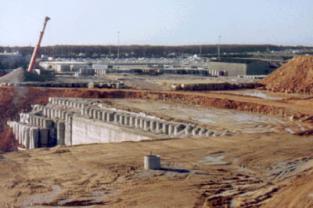The storage site in La Hague has been designed for shallow storage of low to medium activity nuclear wastes for a short to medium period.
It was the first construction of this type in France, and La Hague cover is an experimental field.
The concept of the cover was totally innovative on several points:
- 1st French site for shallow nuclear wastes storage
- Projected lifetime of the cover: 300 years
- Treatment of the residual waters collected
- Construction of the cover step by step (the site being operated meanwhile).
The concept of the protection used for this site was designed by TERRASOL in order to protect the environment against nuclear emissions for a 300 years lifetime. Nuclear wastes are conditioned in concrete shafts laid on a concrete foundation raft, and protected by a multi-layer complex, consisting in (from bottom to the surface):
- A semi-impermeable subgrade, composed of clayey shales
- A fine sand layer
- A bituminous lining
- A drain layer of fine sand
- A biologic barrier composed of semi-impermeablematerials
- A layer of organic topsoil
The monitoring and control of radioactive emissions are an essential mission of ANDRA. The protection system proved to be efficient, with very low Tritium rates in collected waters and Radium rates measured in the air near the site.
Terrasol’s achievements:
- Conception of the multi-layer cover
- Definition of the control processes for the validation of the concept
- Analysis of the real scale tests
- Pre-design of the cover
- Definition of the specifications for the project management mission
- Expertise of the operations after 10 years of use.
 Agent Access
Agent Access 




